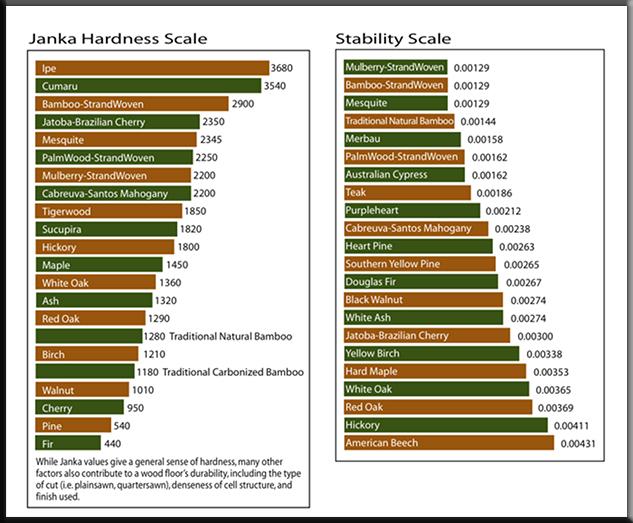So you want to install hardwood floors in your home. Great choice! Of course, you call Accurate Floor Care and ask us what's the best wood to install. As with most design-oriented things, it is largely subjective. We can offer some information to guide your choice.
Red oak and white oak are the most common floors in the US. One of the reasons for this is that they are pretty hardwoods, stable (regarding movement with humidity shifts), versatile, and attractive. All these make oak a great choice. The trends as of late have been towards white oak as the pinkish undertones of red oak have fallen out of favor, and wider width, 3 1/4"+. Anything above 3 1/2" does have to be nailed and glued to avoid stretching the nails holding capacity. In this case, the standard felt paper moisture barrier would not allow a mechanical bond of the glue, so a liquid moisture barrier must be applied.
Hickory is another choice that offers exceptional hardness (more complicated than red and white oak) but lacks stability. Maple is also very hard, but not everyone loves the very light color, and it is notoriously more difficult to change color and can make color blotchy. Walnuts and pines are softer woods. This is not to say these woods aren't good, but it may depend on your lifestyle.
Janka hardness refers to how much pressure it takes to push a small metal ball into a piece of wood, so the higher the number, the more complex the wood.
Stability refers to how much the wood will move with the relative humidity of its environment. Again the lower the number, the more stable the wood.
Besides appearance, hardness, and stability, there are different grades of lumber. The most common names are clear, select, number 1, and number 2. As the name implies, Clear will be the clearest of knots, wormholes, color variation, and grain. Number 2 is on the opposite side of the spectrum. Full of knotholes and color variations. Number 2 will be considerably cheaper, but that does not mean it is a lesser material. I love number 2 lumber. You can fill the knot holes with black putty or epoxy, which looks great. With the right finish in the right home, it is incredible.
Another variable is the cut of the lumber. There are four options: quarter sawn, rift sawn, plain sawn, and live sawn. Quarter sawn is a beautiful cut, with a lot of striping called flecks. It is also much more stable than plain sawn. Rift sawn is the most challenging cut and has an excellent straight and tight grain. Quarter sawn and rift sawn are commonly sold together as a mix but can be bought independently. You can also get a grade with these, such as rift and quartered select or rift and quartered character (number 2). Plain sawn is the most common cut. Within simple sawn, you will usually see a few pieces of rift and quartered that got into the mix. Live sawn is just cutting the tree all in one direction. In this case, you get everything, some rift; some quartered, some plain, and all the knots. It is stunning and has a lot of character.
How each cut is made and an example of each
I hope this is informative and answers more question than it raises. If you have any questions, don't hesitate to give us a call.

